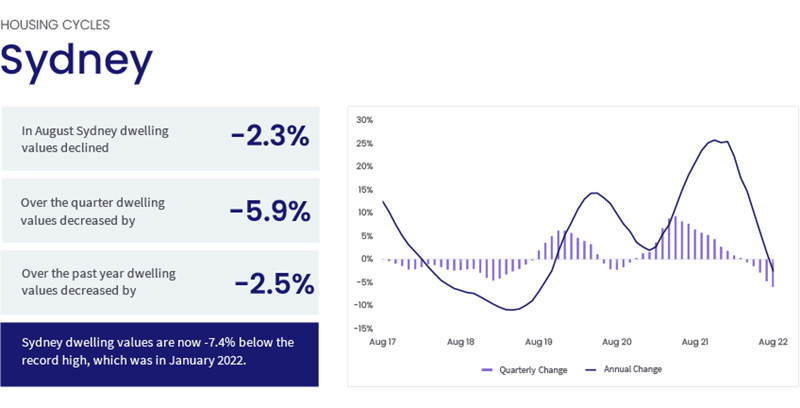Affordable suburbs may offer respite during Sydney property market decline
While economists have forecast further property price falls, some agents are predicting the market will rebound in the lower price points.
Spring will provide a small amount of respite for the Sydney housing market but housing values will continue to fall through to next year, property experts have warned.
Housing Industry of Australia Economist Tom Devitt warned cash rate hikes - the latest of which was 0.5 per cent - had slowed building activity.
“The rise in the cash rate is compounding the impact of the rapid increase in the cost of building a new home that occurred due to the constraints on global supply chains.
“The rising cost of construction would, by itself, have slowed building activity,” he said.
Mr Devitt said the effects of cash rate hikes - which are up 2.25 per cent over the past five months - have led to lower sales.
“In July, new home sales declined by 13.1 per cent and home lending declined for all market segments – renovators, investors and owner occupiers, including first-home buyers,” he said.
“The significant pipeline of work still to complete heading into this cycle will ensure building activity and demand for skilled trades remains exceptionally strong through the rest of 2022 and into 2023.”
Mr Devitt’s warnings arrived as CoreLogic’s national Home Value Index recorded a fourth consecutive month of decline, with the national index recording its largest month-to-month decline since 1983 at 1.6 per cent.
The index found Sydney homes to have dropped the most in value of all capital cities in Australia, down 2.5 per cent over the past year, 5.9 per cent over the quarter and 2.3 per cent over the past month alone.
Home values in Australia’s largest city are expected to continue to drop, said CoreLogic research director Tim Lawless.
“It’s hard to see housing prices stabilising until interest rates find a ceiling and consumer sentiment starts to improve,” he said.
“From current levels, interest rates are likely to increase by at least another 75 basis points and there is a good chance advertised stock levels will accumulate through the spring selling season, providing more choice for buyers and adding further downwards pressure on housing values.”
While Mr Lawless’ predictions appear dim, some agents and property groups reported different figures.
REA Group’s PropTrack report found property in the harbour city to be down just .87 per cent over the past year, down .49 in August alone. PropTrack places the median Sydney home at $991,000 in value, a price up 25 per cent since March 2020.
Signs of life
Paul Ryan, the PropTrack economist behind the report, forecast some bright spring sales activity for the months ahead.
“In the short term, spring will see market activity pick up despite price falls, as buyers and sellers adjust to higher interest rates,” he said.
The increased sales activity will remain temporary with further falls in the market expected through the rest of the year and into 2023.
“We expect home prices to continue to fall across the country in 2022 and into 2023,” he said.
“Regional areas are now falling persistently but continue to be buffered by the affordability and lifestyle appeal that has led these markets to outperform over the past two years,” Mr Ryan said.

While economists have forecast further falls, agents remain more confident, predicting the market will rebound in lower price points following movement in Adelaide and Brisbane, where coastal suburbs and units and townhouses have seen increased activity.
That’s the opinion of BuyersBuyers co-founder Peter Wargent, whose confidence in the market was based on house prices remaining 34 per cent higher than the 2019 election. Property price falls between 1982 and 1983, and 2017 and 2019, had no issue recovering, he said.
“Viewed through this lens, such a correction is hardly surprising, or even problematic,” he said.
“It’s interesting that forecasters are predicting greater declines in this cycle – in some cases significantly greater declines - as the unemployment rate continues to drop to the lowest level in half a century. In July, the unemployment rate fell to a stunningly low 3.4 per cent, though granted housing downturns can precipitate spikes in unemployment.”
BFP Property Buyers principal Ben Plohl shared this enthusiasm, and said buyer enquiries were on the rise at his agency.
“Many savvy buyers have been waiting for this period to arrive as they understood that there were some crazy prices being paid for Sydney property towards the tail-end of last year and decided to sit it out instead,” he said.
Risk raises alert
While properties have not reached pre-pandemic levels, their value had dropped since last year and a peak in January.
“The index reports that Sydney dwelling values are now 2.5 per cent below their level this time last year, but they still remain well above their pre-pandemic levels,” he said.
“The index also showed a 7.4 per drop in dwelling values since the peak of the Sydney market in January this year.”
Mr Plohl remained confident in Sydney real estate, reasoning that most buyers coming into the market weren’t affected by interest rate rises due to owning smaller portfolios.
Sydney property owners have become hypervigilant to market reports and land assessments, with the Sydney Morning Herald last week reporting a recent flooding assessment in the city’s east causing outrage among residents.
The Waverley Council study found 146 properties to be high risk, 1,400 to be medium risk, 3,000 to be low risk and the rest either unrated or “no risk”. Homes in Bondi, Tamarama, Bronte, Waverly and North Bondi were found to be most at risk.




















